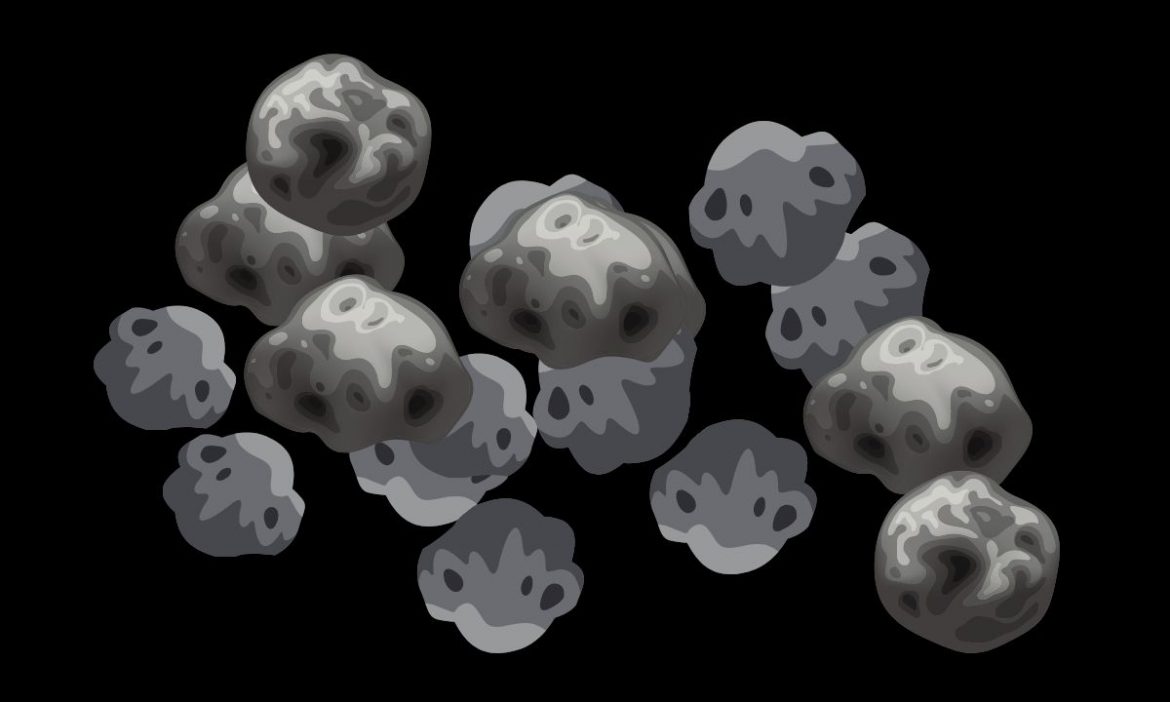Asteroids might seem scary because they may hit Earth, but it has a lot of scientific value about tracing the early stages of the Solar System. So, let’s explore those objects in this article!
How do Asteroids Form?
When we talk about the formation of asteroids, it’s always better to discuss the formation of the Solar System first.
When the Solar System formed, the materials, including gases and rocks, accumulate into the Sun and the planets. However, the materials are not all concentrated in the planets and their moons. There must be something that somehow escapes the gravitational force of the planets. But, they’re not even massive enough to be spherical due to their weak gravity.
That’s where asteroids come into play. So, they are basically leftovers of the ancient Solar System. Most of the rocks are too small to see by a telescope, while a few are hundreds of kilometers wide.

Image Credit: Canva
Compositions of Asteroids
We have many ways to classify asteroids, and one of them uses its composition. Three of the types of the leftovers from the formation of the Solar System are C-type, S-type, and M-type.
C-type asteroids are the most common. They are mostly carbon, so they appear very dark (and are hard-to-find). They also have silicate rocks and even clay. According to NASA, they are some of the oldest objects in the Solar System. Meanwhile, S-type (stony) ones consist of silicate rocks and nickel-iron, and M-type asteroids are metallic.
Location of Asteroids
The majority of these small objects known to date are in the asteroid belt between Mars and Jupiter. With Jupiter’s gravitational influence, the small bodies are prevented from forming another planet or dwarf planet. Instead, they keep their identity of being small fragments floating around in the Solar System, leaving an apparent “belt” in the map of the Solar System.

Image Credit: Canva
Another group is trojans. Keep in mind that they’re neither trojan horses nor infamous types of malware. They share orbits with planets and are secured in either of the two Lagrange points (L4 and L5). They are 60 degrees ahead of or behind the planet, and the most common target for trojans is Jupiter.
There are also trans-Neptunian objects (TNOs), which are asteroids that exist beyond Neptune’s orbit. They have very long orbits as they’re far from the Sun. Some comets even reside further in the Oort Cloud, which is the boundary of the Solar System. Note: This applies to dwarf planets, too.
Other than these types of asteroids that are far away from our planet, there are NEOs (Near-Earth Objects). They can pose a threat to life on Earth if it’s not in the correct place. An asteroid or comet is a NEO when its perihelion (closest point to the Sun) is less than 1.3 AU. They often have unstable orbits and can potentially crash onto our planet, although most of them are harmless.
How can space agencies classify objects that may pose a risk to life on Earth? Well, they have a category called PHAs (Potentially Hazardous Asteroids). They have a MOID (Minimum Orbital Intersection Distance) of less than 0.05 AU and an absolute magnitude of brighter than 22. That means the asteroid can get very close to Earth and is large enough to cause significant damage.
How can Asteroids Cause Mass Extinctions?
However, before proceeding, we must know about the real threats of those dangerous objects first. How can they cause mass extinctions like the one that wiped out the dinosaurs?
When you slam on peas, do they bounce? Well, when an asteroid impacts a planet, it kicks up some dust like the way your hand does, but on a much larger scale. If the object is so large that the force released a massive amount of dust, it will block the sunlight and prevent plants from growing. This ultimately goes all the way up the food chain, causing mass extinctions. For details, please explore the article “What If An Asteroid Hit Earth?“
But…… We Can’t Survive Without Asteroids
Despite the potential harm, asteroids bring a lot of value to life on Earth. That’s because they bring essential materials such as organic molecules and water to Earth, settling down the basic ingredients for life.
The small ones are even more essential if we think about the formation of the Solar System. Without those tiny, insignificant rocks, there would be no rocky planets since we wouldn’t have the building blocks. In that stage, don’t even think about living on Earth — no other planets would be suitable as long as all of them are gaseous.
Conclusion
So, we talked about asteroids in this article and covered some details, including their formation, categories, advantages, and disadvantages. However, we’re not done yet. There’s still a lot of scientific value you can mine from these small-but-intriguing objects. For a starting point, please look at the resources we used to write this article in the next section.
References and Credits
- Charles Q. Choi. (2017, September 20). Asteroids – Facts and Information about Asteroids | Space. Retrieved February 22, 2021, from https://www.space.com/51-asteroids-formation-discovery-and-exploration.html
- (2019, December 19). In Depth | Asteroids – NASA Solar System Exploration. Retrieved February 22, 2021, from https://solarsystem.nasa.gov/asteroids-comets-and-meteors/asteroids/in-depth/
- (n.d.). ESA – Asteroids: Structure and composition of asteroids. Retrieved February 22, 2021, from https://www.esa.int/Science_Exploration/Space_Science/Asteroids_Structure_and_composition_of_asteroids
- Nancy Atkinson. (2015, September 10). What are asteroids? Retrieved February 22, 2021, from https://phys.org/news/2015-09-asteroids.html
- (n.d.). NEO Basics. Retrieved February 23, 2021, from https://cneos.jpl.nasa.gov/about/life_on_earth.html
- Nola Taylor Redd. (2018, May 29). Vesta: Facts About the Brightest Asteroid | Space. Retrieved February 23, 2021, from https://www.space.com/12097-vesta-asteroid-facts-solar-system.html

